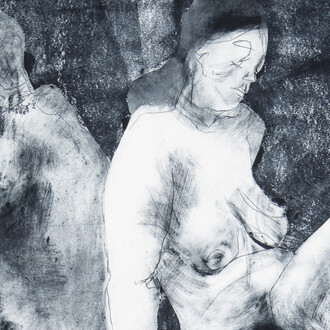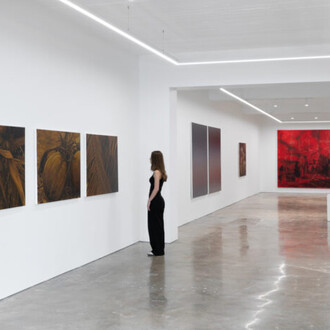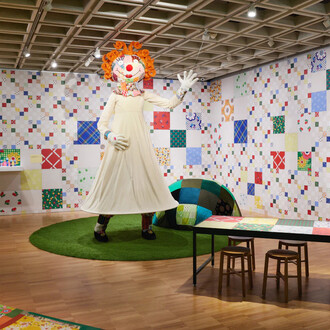For millennia, our First Nations people have had ongoing connection to the land. Where the land meets the sky celebrates this connection, presenting acclaimed artists including Lydia Balbal from the Bidyadanga community, Mangkaja artists Rosie Tarku King and John Prince Siddon, Coen based painter, photographer and ceramicist Naomi Hobson and artists from Iltja Ntjarra (Many Hands) Art Centre. These remote artists are ever present shaping the way we see and will remember landscape. Their work is interlaced with history with each brushstroke and mark detailing moments in time past, present and future, where horizon meets earth and land meets sky.
Mangkaja artist and Sulman Prize finalist John Prince Siddon is a proud Walmajarri man who began his adult life as a stockman working with horses. A severe accident, which caused him to lose his leg, turned his focus to art where the stories of his family, cultural history and his love for pop culture intermingle on his canvas in a swirl of psychedelic colour. Often painting while watching the news, his work is imbued with political messaging presenting his subject to the viewer without restraint. It is a style that Prince calls ‘all mixed up’ and one that conveys we are all intricately connected through culture, history, landscape, animals — and each other. Kangaroos assist spiders with the weaving of their webs, ducks float with lizards through floodwaters helping the other to safety while Scott Morrison’s head sits above words flowing from his mouth that few agree with, characters from Sesame Street intermingle with music stars like Slim Dusty while war is depicted in sharp contrast. It summarises our current culture, where dark histories are forming via the news that plays between fluff pieces on the latest celebrity saga.
Prince holds up a mirror through his work, where we are confronted with societies reflection. He has a selection of work featured in this exhibition including paintings, his acclaimed 3D painted skulls, paintings on repurposed oil drums and LED lights. The major work is Mangarri for the table, a commanding and important piece, detailing the recent class action against the Western Australian government for stolen wages that affected Prince’s family and community. From 1936 – 1972, $180 million worth of wages were stolen from these workers, with the government basically enslaving them in a cycle of constant work that was physical and intense. Mangarri for the table meaning ‘food for the table’ in Walmajarri, is a phrase that expresses an equal playing field, where an exchange of assistance, nourishment and communication is needed for the sustainability of all people, something that was not present in this instance. The painting features a hand painted bull skull standing stark in the middle of the work, representing the labour that was undertaken, and the conditions they were forced to work under. Prince makes direct note of the women in his community who were forced to assist the men at the stations, whilst also caring for young families.
Working from Mangkaja Arts Centre alongside Prince, is Wynne Prize finalist Rosie Tarku King. Growing up in the Great Sandy Desert, King spent much of her youth living nomadically until she ventured with her sister and made the long, arduous journey to Fitzroy Crossing. King depicts this defining moment in her work, detailing the walk across desert, its land formations and markings in jewel like colours of deep purples, glowing magentas, reds, wattle yellows and oceanic blue. Arriving at her destination was a tough experience, with much racism experienced and the separation from her family causing distress. Unable to speak English and confronted with modern technology such as airplanes, it was a completely new, frightening and foreign world to her. Telling her story through her work reforms lost connections, and shares her story with a wide audience of young and old. The paintings are incredibly beautiful, with each layer of paint, each mark of her brush steeped in history and bathed in the words of her story. Now approaching 90, King rarely paints, and many of her recent paintings feature the letter ‘R’ perhaps a way to assert her identity as her memory fades, but also to hold the memory of herself in landscape and time.
On the same side of the Country, working closer to Broome is Bidyadanga artist Lydia Balbal. Her works are not linear in any sense, but rather metaphysical interpretations of her Country where her spiritual connection to place and the sacred relationship she shares with it sweeps across the canvas in effervescent layers of colour. The works vibrate with a sensational rhythm, depicting waterholes that are places of women’s business, protected spaces intricately tied to her identity as an Elder in the community. Balbal paints two stories detailing these places - Winpa and Martakulu - alternating between each. In regards to her work, she states — "I’m painting underground. What’s underground. Upside down: water, rockholes, lines beneath the sand-dunes”. It is as if she is transversing across landscape via the sky, dipping in and out of time.
In 2024, Balbal was awarded the Painting Award in The Telstra National Aboriginal and Torres Strait Islander Art Awards for her work Keeping up with the Balbals an innovative painting done on a repurposed car bonnet. Similar works are featured in ‘Where the land meets the sky’, where the coastal landscape informs her colour palette. Painting ‘wet on wet’, Balbal does not wait for each layer to dry, and instead dots a layer of white over the colours beneath to represent the salt lakes, the effect being that they appear translucent and ephemeral. In this exhibition, one particular work Martakulu (# 841536) burns with colour, with a central circular moment of glowing orange with layers of white dotted over the top, soft gentle pinks line the edge drawing your eye into the work in almost a hypnosis. Balbal paints quickly, and in great bursts of creativity for consecutive days barely taking a break. It is this dedication that has captured the imagination of curators across the world from Paris to New York.
Heading to the top end of Australia, we find Naomi Hobson, a Coen based painter, photographer and ceramicist who has exhibited across the world in major shows at museums such as Horniman Museum in London, the National Photography Museum in Morocco, launched her own book at the Victoria & Albert Museum in London and exhibited at several international art fairs. Coen is a small town in Cape York, Queensland and is unique in its landscape. Rainforest, mountain ranges, beaches and rivers surround the town with Hobson heavily influenced by this varied terrain. She depicts her Country in lively, electrifying colour creating detailed abstract paintings that speak to her love of Country and the histories that are embedded in the place. Her mark making is fervent and energetic with motifs resting over these colour beds of paint. These marks reference her maternal and paternal bloodlines, seeds and plants that grow in nature, the fall of rain, formations of sand dunes or the ocean currents that lick the shore.
One work featured in ‘Where land meets the sky’ is incredibly captivating in both its sheer momentous scale and enigmatic use of colour and form. Smell of rain is a masterful work where Hobson works primarily with shades of blue and dividing the canvas into sections, fragments of red appear, small patches of yellow and moments of lavender pinks rise to the surface. The work is sensory and tactile, recalling the very subject she is depicting – the smell of the rain, it’s gentle caress as it falls from the sky on the earth’s floor and its nourishment of flora and fauna. Her work has been acquired by almost every major museum in Australia with her highly acclaimed photography series ‘Adolescent Wonderland’ as well as her paintings and ceramics now in the collections of the Art Gallery of New South Wales, National Gallery of Australia, National Gallery of Victoria, Art Gallery of South Australia and Queensland Art Gallery of Modern Art to name a few.
The ways in which artists create work can be varied, and it is every artists wish to push the boundaries of their medium, to bend, mould and shape it to their will. The artists at Iltja Ntjarra (Many Hands) Art Centre have done just that with their evocative and important paintings on repurposed road signs. Descendants of the great Albert Namatjira, the artists continue their relatives legacy honouring the watercolour style of his work. The paintings featured in Where the land meets the sky are all painted on repurposed road signs; the artists incorporating the slogans into their paintings. Words are added and removed in a process of destruction and reformation, emboldening the signs with new meanings and phrases that are politically charged. Signs that once stood on Country enforcing speed limits or Westernised place names are altered. No longer signs of Western law, they are now signs showing the law of the artists, a call to protect and conserve our landscape, celebrate its diversity and protect its endangered wildlife and environment.
The largest work in the exhibition from these artists is a collaborative painting by Carita Coulthard, Dianne Inkamala, Everard Pei Pei, Jonathon Price, Reinhold Inkamala, Delray Inkamala, Mandy Malbunka . Titled Enough is enough, the painting is comprised of 12 panels detailing the impact, threat and influence the police have over Alice Springs. The faces of Elder’s hover above as a guiding force, representing a community that is under threat. Selma Coulthard a senior artist at the centre comments that – “Alice Springs is a special place, a beautiful place for people to come and enjoy. In recent times more and more police have been sent to Alice Springs from other places to fight ‘youth crime’. However their way of doing it is through violence and locking kids up, our way is that people talk. Kids are kids, maybe it’s our job to bring the kids in line, through our elders, not the police who use their force. Our past generations that held this place together are still within us, still helping us to create this beautiful place. By caring for each other we can keep people safe, by being strong in what we are doing, especially through our children.” This care is carried through in the work, celebrating their connection to landscape and each other.
To be able to state that we live in a place with the oldest living culture in the world is both incredible and awe inspiring, a history and culture that these artists visually present to us in a sharing of knowledge through painting, sculpture, photography, ceramics and installation. ‘Where the land meets the sky’ is a celebration as much as a quiet moment of reflection – to pause, look, learn and consider the First Nations history that is vital to all of us.
(Text by Emily George)















